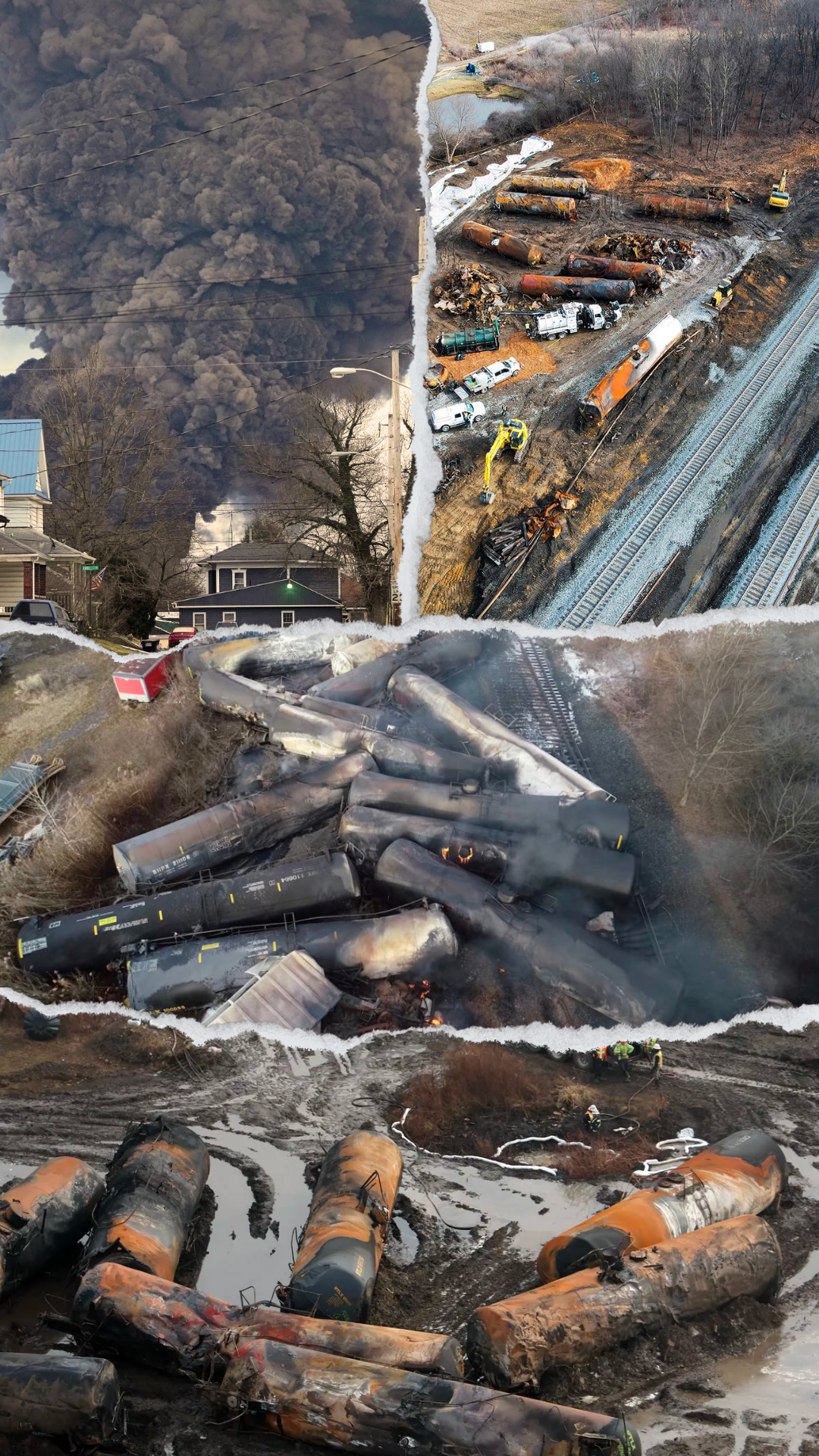The cloudy truth of the Ohio train derailment
By Nathan Cheng
Designed by Hilary Lo
In early February, Ian Jefferies represented the Association of American Railroads in testimony to U.S. Congress, making a case for why the Federal Railroad Administration should deregulate the rail industry.
A few days later, the East Palestine train derailment incident left the authorities with a problem: how to dispose of the 100,000 gallons of toxic chemicals dumped in its wake. But this incident reveals a more serious story — corporate greed and big business poisoning the United States of America.
The eleven derailed train cars had chemicals - most notably, vinyl chloride and butyl acrylate - with two common attributes: flammability and combustibility. Vinyl chloride is a carcinogen used in plastic production that releases chemicals capable of internally choking people when burnt. Butyl acrylate irritates the eyes, skin and respiratory system, releasing carbon dioxide and carbon monoxide upon burning.
Although the Environmental Protection Agency (EPA) considered directly removing these chemicals from the disaster, they decided to burn it under control instead. In theory, this would reduce the severity of the toxic chemicals and minimise possible chemical reactions. This led to the toxic smoke in the disaster’s aftermath — which the media ironically used as pictures for the disaster.
While successfully removing the chemicals, the toxic smoke had far worse impacts on the surrounding environment, as dioxins also came down onto the soil. While these weren’t too significant, they were still above EPA thresholds, and the health risks were still a serious concern. Sil Caggiano, a hazardous material expert, can perfectly describe the situation: “We nuked a town with chemicals to get a railroad open.”
Only under EPA pressure did Norfolk Southern finally decide to give the region one million dollars in aid. For all the damage citizens of East Palestine had to endure, one million dollars seemed nothing but performative — especially considering that Norfolk’s profits in 2022 were over five billion dollars.
With Norfolk Southern’s track record of lobbying Congress, this is not the first time they have actively obstructed safety legislation to protect profits. Norfolk Southern, alongside several other companies, stopped enforcing the Enhanced Tank Car Standards in 2018, which made more efficient brakes mandatory on all hazardous material trains. This pattern of lobbying against safety regulations is a case of cost-benefit analysis: while accident prevention and safety are essential, profits are ultimately prioritised over them.
Some have accused Norfolk Southern’s long trains and inadequate workforce as the culprits of this accident. This links to a strategy called Precision Scheduled Railroading (PSR), which aims to reduce operational costs to increase revenue. So how is it related to Norfolk Southern and the derailment?
The train was over 1.7 miles (2.7 km) long. A 2019 report found that trains are around 25% longer than trains from 2008.
This means they can operate trains with fewer crew members — data shows a ⅓ reduction in Norfolk southern employees from 2012 to 2022.
This may have led to the crew’s inaction to sparks on one of the car’s wheels, which could easily have been detected by hotbox detectors that were left unrepaired due to a lack of maintenance workers.
A crucial part of PSR is the “scheduled” part: trains operate on a tight schedule to maximise efficiency. This means that safety inspectors struggle to complete safety inspections — made worse by the fact that trains in 2023 are ridiculously long.
It’s ironic that while rail companies and people like Ian Jefferies flaunt the accomplishments of the rail industry, they’re more concerned about money than the longevity and sustainability of railroads. The longer we ignore these problems, the more accidents will happen, and the more we enable executives to continue these abhorrent practices. We are far better off without the sin of greed-seeking through the rail industry.
Relevant information
https://nj.gov/health/eoh/rtkweb/documents/fs/2001.pdf
https://www.nj.gov/health/eoh/rtkweb/documents/fs/0278.pdf
https://www.epa.gov/dioxin/learn-about-dioxin
Bibliography
https://docs.house.gov/meetings/PW/PW00/20230201/115263/HHRG-118-PW00-Wstate-JefferiesI-20230201.pdf
https://newrepublic.com/post/170675/norfolk-southern-spent-roughly-100-million-politics-since-1990
https://www.kyowa-ei.com/eng/product/sector/railroad/application_103.html
https://www.freightwaves.com/news/the-perils-of-precision-scheduled-railroading https://www.prnewswire.com/news-releases/norfolk-southern-reports-q4-and-full-year-2022-results-301730030.html
https://www.sightline.org/2021/02/26/a-timeline-of-oil-train-derailments-in-pictures/
https://www.gao.gov/assets/gao-19-443.pdf
https://www.macrotrends.net/stocks/charts/NSC/norfolk-southern/number-of-employees
